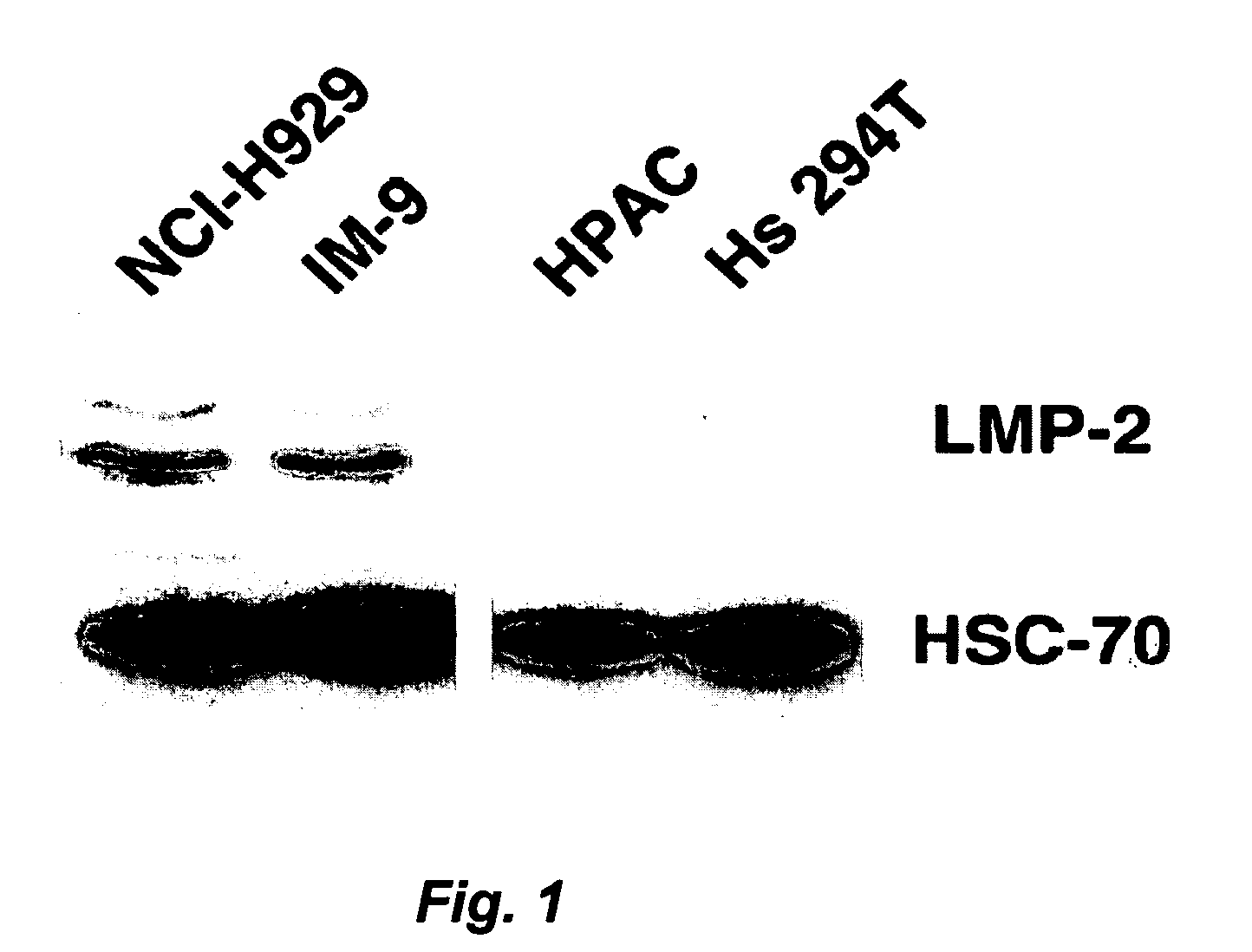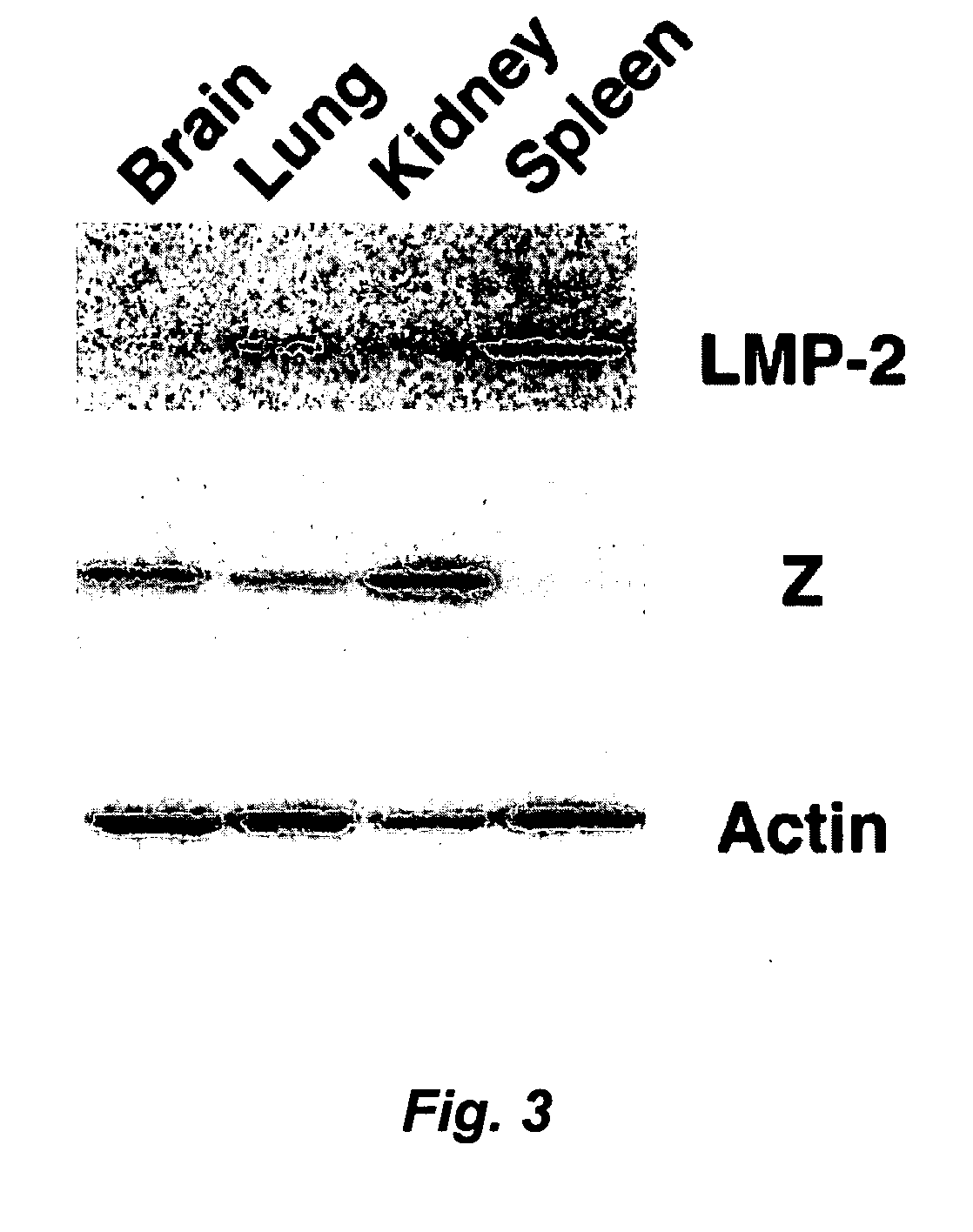Potent and specific immunoproteasome inhibitors
a technology of immunoproteasome and inhibitor, which is applied in the direction of peptides, drug compositions, metabolic disorders, etc., can solve the problems of limiting clinical utility, and achieve the effect of little to no ability to inhibi
- Summary
- Abstract
- Description
- Claims
- Application Information
AI Technical Summary
Benefits of technology
Problems solved by technology
Method used
Image
Examples
example 1
In Vitro Study of Proteasome Specificity
[0317] To investigate the possibility that inhibitors specific for the immunoproteasome could be identified, the proteasome from pituitary tissue, representative of the X / Y / Z isoform (i.e., the constitutive proteasome), and the proteasome from spleen tissue, representative of the LMP-2 / 7 / 10 isoform (i.e., the immunoproteasome), were each purified to homogeneity. A panel of peptidyl-aldehyde substrate-related inhibitors were then screened for their ability to inhibit the chymotrypsin-like (ChT-L) and branched chain amino acid preferring (BrAAP) activities of these two proteasome preparations. Some peptide aldehydes, such as Cbz-LLL-CHO, also known as MG-132 (AG Scientific, Inc., San Diego, Calif., United States of America), demonstrated comparable abilities to inhibit the ChT-L and BrAAP components of both the spleen and pituitary proteasomes (see Table 1), suggesting that they were non-specific. The same was true for Cbz-FL-CHO, the peptide a...
example 2
Immunoproteasome Expression in Cancer Cell Lines
[0322] Protein extracts were prepared from NCI-H929 human myeloma cells, IM-9 human B-lymphoblasts, HPAC human pancreatic adenocarcinoma cells, and Hs 294T human melanoma cells. The protein extracts were then subjected to Western blotting for the detection of the LMP-2 subunit, and then stripped and reprobed with antibodies recognizing HSC-70.
[0323] As illustrated in FIG. 1, LMP-2 is expressed in both of the B-lymphocyte lineage-derived cells, but virtually absent in the pancreatic carcinoma and melanoma cell lines. This observation supports that expression of the proteasome containing LMP-2 / 7 / 10 subunits is relatively restricted to cells of lymphatic origin in comparison with other cell lines. In addition, it indicates that the process of transformation in at least these two solid tumors has not activated expression of LMP-2 subunits. HSC-70 serves as a control to verify equal protein loading in all of the lanes.
example 3
Proteasome Inhibitor-Induced Apoptosis
[0324] Cultured NCI-H929 human myeloma cells, IM-9 human B-lymphoblasts, HPAC human pancreatic adenocarcinoma cells, and Hs 294T human melanoma cells were exposed to vehicle, 5 nM bortezomib (PS-341), or 50 μM Cbz-LnL-CHO for 18 hours. Apoptosis was evaluated using an enzyme-linked immunosorbent assay that detects apoptotic nuclear DNA fragmentation. Cell death is expressed as the fold-increase in apoptosis over the vehicle control, which was arbitrarily set at 1.0. Referring now to FIG. 2, the effect of PS-341 is shown in the open bar graphs, while Cbz-LnL-CHO (IPSI-001) is in the stippled bar graphs. The mean and standard error of the mean are shown for each condition from four independent experiments.
[0325] Bortezomib, a non-specific proteasome inhibitor, induces apoptosis roughly equally in all of the cell lines tested. Cbz-LnL-CHO, which is able to preferentially inhibit only proteasomes containing the LMP-2 / 7 / 10 subunits, induces signifi...
PUM
| Property | Measurement | Unit |
|---|---|---|
| particle size | aaaaa | aaaaa |
| particle size | aaaaa | aaaaa |
| particle size | aaaaa | aaaaa |
Abstract
Description
Claims
Application Information
 Login to View More
Login to View More - R&D
- Intellectual Property
- Life Sciences
- Materials
- Tech Scout
- Unparalleled Data Quality
- Higher Quality Content
- 60% Fewer Hallucinations
Browse by: Latest US Patents, China's latest patents, Technical Efficacy Thesaurus, Application Domain, Technology Topic, Popular Technical Reports.
© 2025 PatSnap. All rights reserved.Legal|Privacy policy|Modern Slavery Act Transparency Statement|Sitemap|About US| Contact US: help@patsnap.com



